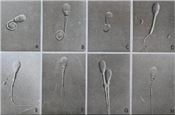|
The Importance Of Breeding Soundness Exams For Herd Bulls

This image shows examples of abnormalities found in sperm. These sperm are incapable of fertilizing a cow’s egg and should
be very few in numbers of a competent bull’s collection.
ELIZABETH PICKING
WEST PLAINS, MO.
In order to have a successful breeding season, many things must come together. Herd health, nutrition, genetics, and cow and bull fertility are all important in determining pregnancy rates. Each one of these considerations alone can cause a large reduction in pregnancy rates if lacking however, bull infertility can be the most devastating to a cattlemen’s pregnancy rates. Occasionally, Extension Specialists hear about producers who have gotten virtually no cows bred during a breeding season due to an infertile or injured bull. Determining issues with bull fertility or injury by having a vet conduct a breeding soundness exam (BSE) before the breeding season is the key to prevent these breeding season wrecks.
A breeding soundness exam consists of a physical evaluation of the bull and an evaluation of the bull’s semen. The physical evaluation looks for any lameness issues which may discourage the bull from mounting cows such as injury to the hocks, or poor formation of the claws causing soreness. The veterinarian will also look for lack of teeth causing weight loss, cataracts forming on the eyes, and injuries or abnormalities to the sheath, penis, or testicles. All of these issues may prevent a bull from seeking out and breeding cows and heifers. When doing an initial BSE on a young or recently purchased bull, scrotal circumference should also be taken. Scrotal circumference is directly related to the amount of sperm a bull can produce, as well as the age of puberty of that bull’s offspring. The larger the bull’s scrotal circumference, the more sperm is produced, and the earlier his offspring will reach puberty.
The Table shows the minimum desired scrotal circumference based on the bull’s age in order for the bull to have adequate concentration of sperm.
During a BSE, the veterinarian will also collect semen from the bull and evaluate the concentration (number of sperm), motility (whether the sperm are progressively moving forward), and morphology (whether there are many abnormally formed sperm).
Ultimately, there are 3 potential outcomes of a BSE. A bull can be satisfactory (the bull can adequately get cows bred), Unsatisfactory (the bull has some issue/issues that make him unable to be a successful herd bull), or deferred (the bull currently has an issue/issues which may resolve with time and/or treatment).
A BSE should be conducted on a bull roughly 60-90 days before every breeding season. For producers who use the same bull on spring and fall calving herds, it would be best to have a BSE done twice/year. A single round of spermatogenesis (the creation of new sperm) takes 61 days, so if an issue was identified with a bull’s semen, a new BSE could be completed 2 months later to see if the problem has subsided with the creation of new sperm or if it is a chronic issue. Completing a BSE 60-90 days before the breeding season also allows producers more time to make arrangements to get their cows bred if an issue is found.
For more information on breeding soundness exams, speak with a trusted veterinarian or contact Elizabeth Picking Livestock Specialist at the Howell County Extension Center via phone 417-256-2391 or by email at pickinge@missouri.edu . ∆
Age of Bull Minimum Scrotal Circumference
15 monhs 30 cm
18 months 32 cm
24 months and older 34 cm
|
|